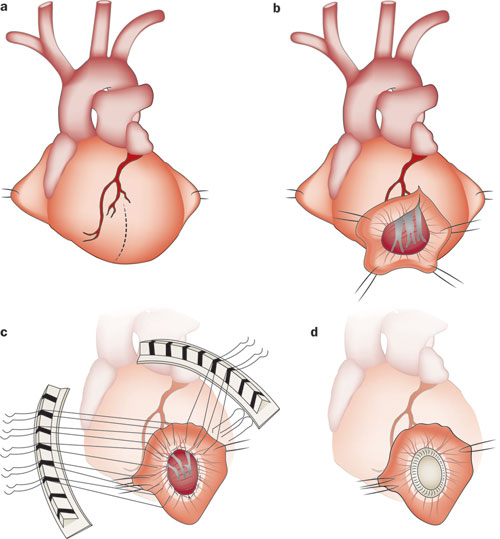 Left ventricular reconstruction surgery procedure is sometimes used to treat heart failure. When a heart attack occurs in the left ventricle (left lower pumping chamber of the heart), a scar may form. The scarred area starts bulging and thinning out with each beat. The bulging thin area is called an aneurysm. An aneurysm, along with other heart damage, makes your heart work harder to pump blood throughout your body. Initially, your heart can handle the additional work, but over time, your left ventricle becomes larger than normal and pumps less effectively.
Left ventricular reconstruction surgery procedure is sometimes used to treat heart failure. When a heart attack occurs in the left ventricle (left lower pumping chamber of the heart), a scar may form. The scarred area starts bulging and thinning out with each beat. The bulging thin area is called an aneurysm. An aneurysm, along with other heart damage, makes your heart work harder to pump blood throughout your body. Initially, your heart can handle the additional work, but over time, your left ventricle becomes larger than normal and pumps less effectively.
Left ventricular reconstructive surgery (or aneurysm repair surgery) allows the surgeon to remove the scarred, dead area of heart tissue and an aneurysm returning the left ventricle to a more normal shape. The goal is to improve heart failure and also angina (chest pain) symptoms. And also possibly improve the pumping ability of your heart.
Other Names for Left Ventricular Reconstructive Surgery
Various surgeons who have published their experiences use different names to describe the procedure. Here are some other terms that describe the same or a similar procedure:
- Aneurysm repair surgery
- Endoventricular Circular Patch plaster repair
- Dor, or modified Dor, procedure (to credit Vincent Dor, MD, who authored many articles on the procedure he began performing in the early 1980s)
- Surgical ventricular restoration
- Left ventricular infarct exclusion surgery
- Left ventricular aneurysm ectomy reconstruction
- Surgical anterior ventricular endocardial restoration
Who is eligible for left ventricular reconstructive surgery?
Not all patients with heart failure qualify for this procedure. Patients who may benefit from left ventricular reconstructive surgery include patients who:
- Have had a heart attack that resulted in an aneurysm or a scar in the left ventricle. And also has symptoms of heart failure (such as shortness of breath, fatigue, swelling and others) that are not relieved with medications and lifestyle changes.
- Have severe coronary artery disease with symptoms of angina.
- Have valve problems that require surgical treatment.
Some patients who have these conditions may also have ventricular tachycardia (an abnormal rhythm originating in the left ventricle that makes it beat too quickly). Symptoms include passing out, feeling lightheaded, or feeling a rapid pounding in the chest also.
If you have one or more of the conditions listed above then you may be a candidate for left ventricular reconstructive surgery. Your surgeon will decide whether left ventricular reconstructive surgery is a suitable treatment for your condition.





